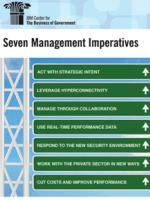
Seven Management Imperatives: Act with Strategic Intent

The United States federal government operates in a period rife with significant, seemingly intractable challenges, including an evergrowing federal deficit, economic uncertainty, unemployment, and an aging infrastructure. These challenges go to the core of effective public management. As Don Kettl notes in Reflections on 21st Century Government Management, many problems faced by government allow little time to react; have a high cost of failure; and tend to be critical to citizens’ needs. In addition, responsibility for solving these problems often is highly diffused.
Despite the many challenges facing today’s government leaders and managers, a single constant remains—the critical importance of achieving an organization’s mission with strategic intent.
What is Strategic Intent?
For today’s government leaders and managers, it is imperative to work toward executing their mission with strategic intent. Strategic intent focuses on an organization’s vision, goals, and objectives necessary to achieve its mission; it is marked by clarity of focus, a desired end, a flexibility of means, with criteria used to chart progress. It represents a need to think ahead and plan backward from an envisioned future, making it clear how to take effective action in the present.
Benefits of Acting with Strategic intent
When government leaders act with strategic intent, they can better steer their agencies and help them:
- Anticipate Non-Routine Problems
Today’s increasingly complex public management problems do not respect bureaucratic boundaries; by focusing on strategic intent--rather than org charts--government leaders will be able to confront and surmount emergency and exceptional circumstances as they arise. - Manage People and Resources
It is vital that today’s government leaders and managers develop ways to access the talent pool outside the traditional 30-year career employment model. According to James Thompson and Sharon Mastracci, that model greatly impedes managerial flexibility when either rapid increases in demand require more staff or budget reductions require less. It is critical that today’s government manager recognize the viability of nonstandard work arrangements, including part-time, seasonal, and on-call workers, as well as temporary agency and contract personnel.
Using Tools and Technology to Facilitate Strategic Intent
Government executives today have a host of tools and a vast array of technologies that they can harness to meet their missions. Given this new operating environment, it is imperative that government executives view these tools and technologies through the prism of both their mission and strategic intent.
The world has moved from a PC-centric to an Internet-centric universe; today’s government executives should recognize that technology trends such as cloud computing undoubtedly will change how agencies approach IT
Another new strategic tool is analytics. David McClure, associate administrator at the General Services Administration, notes “We’ve created a tsunami of information and data. We’ve got to be able to use, sift, analyze, and get value out of this information because it’s a gold mine.”
Conclusion
Tom Shoop points out in the February 2011 issue of Government Executive that “mission clarity is one of the strongest predictors of success, and conflicting missions can bring an agency to its knees.” It is a management imperative for government executives today to keep their mission front and center. Keeping focus on the strategic intent of mission is key.
Read more details in the Center report, Seven Management Imperatives.



